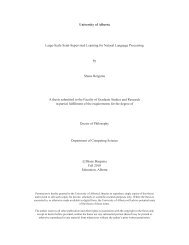The high altitude wildlife areas of western Arunachal Pradesh
The high altitude wildlife areas of western Arunachal Pradesh
The high altitude wildlife areas of western Arunachal Pradesh
Create successful ePaper yourself
Turn your PDF publications into a flip-book with our unique Google optimized e-Paper software.
Introduction<br />
continent 22 . Some research projects 23-26 have also been undertaken in these <strong>areas</strong> over<br />
the last five years. Observations on smaller carnivores, other mammals and turtles in<br />
the area have been published 27-30 . <strong>The</strong>se few surveys and ecological studies conducted<br />
in the state have yielded important discoveries and information 15,23,25,31 , but many<br />
<strong>areas</strong>, especially in the <strong>high</strong> <strong>altitude</strong>s still remain unexplored. <strong>The</strong> only exception is a<br />
survey <strong>of</strong> pheasants in mid elevation forests and alpine <strong>areas</strong> 15 .<br />
<strong>The</strong> expedition<br />
History<br />
<strong>The</strong> Nature Conservation Foundation has a <strong>high</strong> <strong>altitude</strong> program, which is a<br />
conservation partnership with the International Snow Leopard Trust. In response to a<br />
questionnaire survey by NCF-ISLT in 2002, <strong>Arunachal</strong>’s Wildlife Department <strong>of</strong>ficials<br />
(<strong>The</strong> Chief Wildlife Warden and Mr. Pekyom Ringu, DCF) expressed a strong need<br />
for exploring the <strong>high</strong> <strong>altitude</strong> <strong>wildlife</strong> <strong>of</strong> the state, and identifying <strong>areas</strong> for<br />
conservation. NCF has so far been working in Namdapha National Park in eastern<br />
<strong>Arunachal</strong>. Given the <strong>wildlife</strong> department’s seriousness in conserving <strong>Arunachal</strong>’s<br />
<strong>high</strong> <strong>altitude</strong> <strong>wildlife</strong>, and in response to their request, we decided to undertake this<br />
biological expedition collaboratively with our partners, the ISLT and the Wildlife<br />
Conservation Society (India Program). Two international conservation agencies, <strong>The</strong><br />
Rufford Foundation and the Van Tienhoven Foundation, came forward to support<br />
the bulk <strong>of</strong> the expedition costs. <strong>Arunachal</strong>’s <strong>wildlife</strong> department agreed to provide<br />
the expedition support in terms <strong>of</strong> permissions and technical advice.<br />
Objectives<br />
During this expedition, we specifically aimed to:<br />
1. Inventory the occurrence <strong>of</strong> mammals and avifauna in the <strong>high</strong> <strong>altitude</strong>s <strong>of</strong><br />
<strong>Arunachal</strong> <strong>Pradesh</strong>, and map <strong>wildlife</strong> habitats<br />
2. Assess the status <strong>of</strong> <strong>high</strong> <strong>altitude</strong> <strong>wildlife</strong> and identify important threats to<br />
their conservation<br />
3. Prepare a preliminary pr<strong>of</strong>ile <strong>of</strong> the socio-economic status and natural<br />
resource use among the resident people in the <strong>high</strong> <strong>altitude</strong>s<br />
4. Identify <strong>areas</strong> with long-term conservation potential for establishing <strong>wildlife</strong><br />
reserves in the <strong>high</strong> <strong>altitude</strong>s <strong>of</strong> <strong>Arunachal</strong> <strong>Pradesh</strong><br />
<strong>The</strong> area<br />
<strong>The</strong> survey was originally planned over three districts, namely, Tawang, West Kameng<br />
and East Kameng. However, considering field logistics, we opted to cover the entire<br />
<strong>high</strong> <strong>altitude</strong> <strong>areas</strong> <strong>of</strong> Tawang and West Kameng comprehensively, instead <strong>of</strong> partially<br />
covering all three districts. Tawang District spans over 2172 km 2 with a human<br />
population density (16 per km 2 ) marginally exceeding the average for <strong>Arunachal</strong> (13<br />
per km 2 ) 11 . <strong>The</strong> region is drained by the Tawang Chu, Nyamjang Chu (both <strong>of</strong> which<br />
meet and drain into Bhutan) and their tributaries, and comprises five administrative<br />
circles (Tawang, Mukto, Thingbu, Lumla, and Zemithang). <strong>The</strong> Buddhist Monpa tribe<br />
is the predominant community inhabiting Tawang. <strong>The</strong>re is a considerable presence<br />
3

















